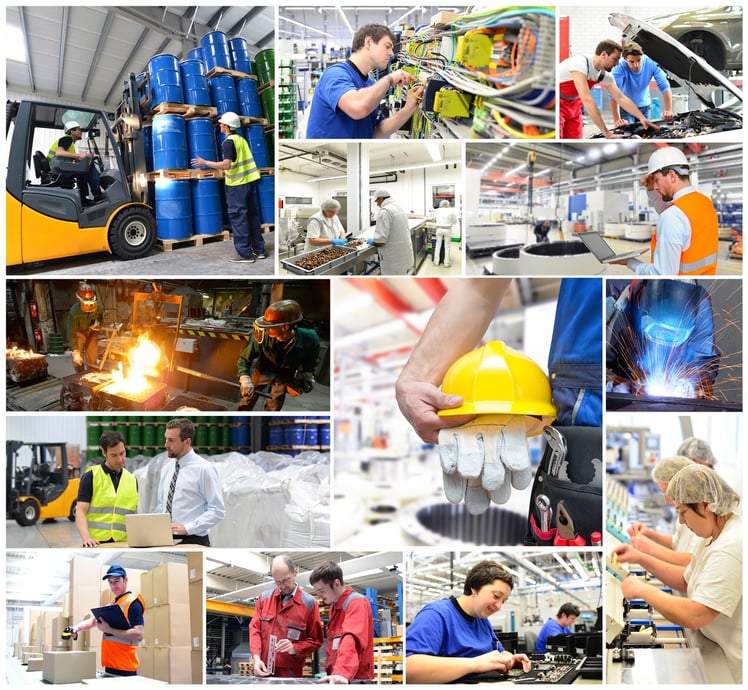August 4, 2017 | Made in California, Human Resources, Employee Training
How to Overcome Common HR Challenges in Manufacturing

The evolution from manual methods to advanced techniques (i.e. the creation of goods and services) has become a complex process, giving rise to a host of HR challenges in manufacturing.
The National Association of Manufacturers (NAM) paints a positive outlook for the U.S. manufacturing industry. NAM’s most recent data shows that the manufacturing sector contributed about $2.18 trillion to the U.S. economy in 2016, accounting for 11.7% of GDP. This is a significant increase of almost half a trillion dollars from recession-stricken 2009.
A Census Bureau report also indicates that California is still home to the largest manufacturing sector. Among all the states, California had the highest number of manufacturing businesses at more than 38,000 in 2012, with about 1.2 million workers producing goods valued at more than $500 billion.
These encouraging developments in the workforce highlight the importance of mitigating the risks posed by HR challenges in manufacturing. The challenges vary across manufacturing categories, such as food and beverages, chemicals, textile, construction, pharmaceuticals, automobiles, electronics, and energy, among many others.
Common HR Challenges in Manufacturing
Difficulty in recruiting and retaining skilled talent
Recruiting and retaining talent with skills unique to specific manufacturing niches is one of the challenges in manufacturing that continues to confront employers. In fact, a Tooling U-SME Millennial survey revealed 8 out of 10 manufacturers have concerns about meeting workforce demands over the next 5 years.
Employees with specialized skill sets are hard to find, and the scarcity of candidates makes positions hard to fill up. While mechanization and automation have taken over vast areas of manufacturing, skilled workers are still needed throughout the manufacturing process.
Solution – Recruitment is the heart of any meaningful recruitment strategy and doing it alone can be a setback. When internal resources are not enough to find the right talent, employers need to look for recruitment services that specialize in customizing candidate searches to meet their company’s talent needs.
Recruitment services usually involve a 3 step process:
- Defining the needs for your position/job title
- Sourcing and screening for pre-qualifying candidates and conducting interviews
- Presenting top-tier candidates and obtaining feedback
It’s important to take the necessary time to find the maximum number of highly-qualified individuals, as recruiting is expensive. Defining your needs before searching will help you overcome hurdles in the later interview and recruiting process. Have questions and necessary skillsets as a requirement for applying.
Also, consider apprenticeship programs for qualified talent. These programs, similar to college, offer young adults the opportunity to train in practical and class work in order to fulfill critical thinking necessary for manufacturing positions. There’s a clear need for workers who can inspect and design products and machinery far beyond pushing a button, and these apprenticeship programs are viable resources to discover that talent.
Employee deficiencies in requisite skills
In a survey conducted by Deloitte, manufacturing employers reported that the most serious skill deficiencies of their current employees are:
- Technology and computer skills at 70%
- Problem-solving skills at 69%
- Basic technical training at 67%
- Math skills at 60%
The skills gap helps trigger a succession gap that can disrupt business continuity. Prolonged vacancies significantly add to HR costs on downtime, overtime, and production-cycle time.
Solution – By creating an adaptive talent supply chain, disruptive technologies will not impede process life cycles. The supply chain model will foster continual talent training, including cross-functional development where employees are encouraged to go on tours of duty to different parts and regions of the company to learn new skills on the job.
Safety
Safety is one of the HR challenges in manufacturing that involves protecting workers from the physical dangers of processes and machines. In a plant or factory, for example, people can accidentally cut themselves by improperly handling machines or tools. Others may trip over slippery floors or sustain severe injuries.
Solution – Safety can be achieved by making manufacturing safety training a priority. Training should include identifying training needs, timely training schedules especially for new procedures and other changes, conducting emergency drills, maintaining machinery and equipment, and posting safety warning signs in strategic locations. More importantly, as the lead safety enforcer, you need to show your employees that you’re following the rules by wearing your own hard hat, safety glasses, and respirator mask.
Mitigate Your HR Challenges
HR challenges in manufacturing cannot be completely eliminated, but they can be mitigated considerably by redefining HR’s approach to the recruitment, management, and development of talent. It takes time, and a cohesive team to identify issues and implement the proper controls.
We hope these solutions were helpful to jumpstart your organization’s HR challenges. As time goes on, these needs will evolve and change, and you need to stay vigilant and be sure your business is ready to combat them. By implementing these solutions, you will be.


Leave a Comment